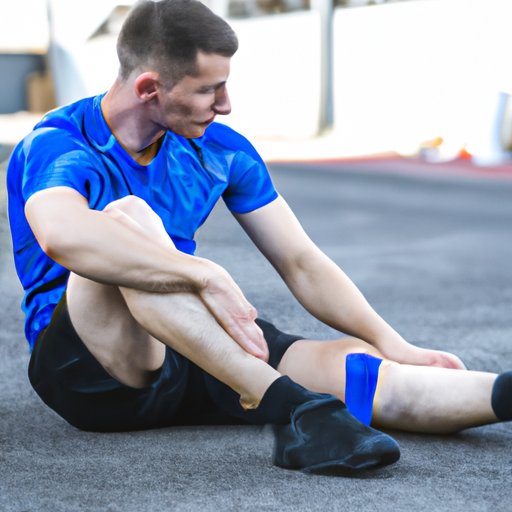Introduction
Muscle soreness is a common experience for many people who exercise regularly. It typically occurs after an intense workout or when you start a new exercise program. While it can be uncomfortable, it’s important to understand the science behind why your muscles are sore after working out so you can properly prevent and treat it.

Exploring the Science Behind Muscle Soreness
The scientific term for muscle soreness is delayed onset muscle soreness (DOMS). It occurs when there is microscopic damage to the muscle fibers caused by strenuous activity. According to a study published in the Journal of Strength & Conditioning Research, DOMS is “characterized by pain and tenderness with a peak intensity 24–48 hours after exercise.”
While it may be uncomfortable, DOMS can have some positive benefits. For example, it increases blood flow to the affected area which helps speed up the muscle healing process. Additionally, it can also serve as a sign that you’re pushing your body in the right way and making progress with your fitness goals.

How to Prevent and Treat Sore Muscles After Exercise
In order to prevent and treat sore muscles after exercise, there are several steps you can take. Here are some of the most effective strategies:
- Proper warm-up: Before any physical activity, it’s important to do a proper warm-up. This can include light jogging, dynamic stretches, and foam rolling. Warming up helps increase blood flow to the muscles and gets them ready for exercise.
- Appropriate intensity: When starting a new exercise program, it’s important to gradually increase the intensity over time. This will help reduce the risk of DOMS. If you find yourself feeling overly sore after working out, it may be a sign that you’re pushing too hard.
- Stretching: Stretching is another great way to prevent and treat muscle soreness. Dynamic stretching before exercise helps increase flexibility and range of motion. Static stretching after exercise helps reduce tension in the muscles and relax them.
- Hydration: Staying hydrated is key for preventing and treating muscle soreness. Dehydration can lead to cramping, fatigue, and soreness, so make sure you’re drinking enough water throughout the day.
An Overview of Common Causes of Post-Workout Soreness
There are several reasons why you might be feeling sore after working out. Here are some of the most common causes:
- Overtraining: Overtraining is when you’re doing too much exercise without giving your body enough rest and recovery time. This can lead to fatigue, soreness, and even injury.
- Poor form: Poor form can also contribute to muscle soreness. Make sure you’re using the correct technique when performing exercises in order to reduce the risk of injury and soreness.
- Lack of recovery: If you don’t give your body enough time to recover between workouts, it can lead to soreness and fatigue. Make sure you’re taking at least one full day off per week and getting enough sleep each night.

A Guide to Proper Recovery After an Intense Workout
Proper recovery is essential for preventing and treating post-workout soreness. Here are some tips for recovering from an intense workout:
- Rest and relaxation: Make sure you’re taking time to rest and relax after an intense workout. This will give your body time to repair and rebuild the damaged muscle fibers.
- Nutrition: Eating a balanced diet is also important for recovery. Make sure you’re getting enough protein, carbohydrates, and healthy fats to fuel your body and help with muscle repair.
- Compression gear: Wearing compression gear such as tights, socks, or sleeves can help reduce inflammation and speed up the recovery process.
Understanding the Relationship Between Exercise and Muscle Soreness
It’s important to understand the relationship between exercise and muscle soreness. While there is a positive correlation between the two, it’s important to remember that soreness should never be seen as a punishment. Instead, it should be seen as a sign that you’re pushing yourself and making progress with your fitness goals.
In order to manage DOMS, it’s important to listen to your body and be mindful of the signs of overtraining. Make sure you’re giving your body enough rest and recovery time between workouts and eating a balanced diet. Additionally, make sure you’re warming up properly before exercise and stretching afterwards. These steps will help reduce the risk of soreness and help you reach your fitness goals.
Conclusion
Muscle soreness is a common experience for many people who exercise regularly. Understanding the science behind why muscles are sore after working out is key for preventing and treating DOMS. Proper warm-up, appropriate intensity, stretching, hydration, and recovery are all important for reducing the risk of soreness and helping you reach your fitness goals.
(Note: Is this article not meeting your expectations? Do you have knowledge or insights to share? Unlock new opportunities and expand your reach by joining our authors team. Click Registration to join us and share your expertise with our readers.)
